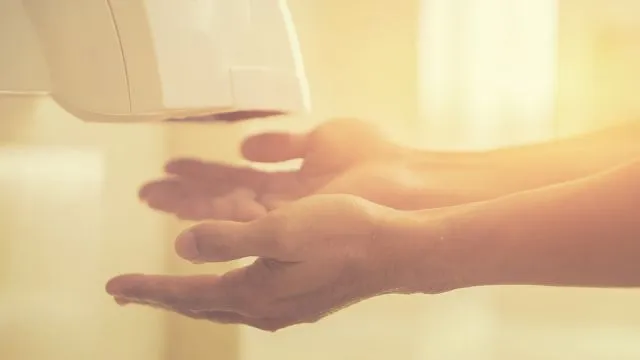
- Share on Facebook110
- Share on Pinterest
- Share on Twitter
I am always leery when I use public toilets. What is lurking on the seat, under the seat, and in the bowl? All those people in and out tracking bacteria all over the place make me cringe. This is even more so now with everything that is going on in the world. Read on to discover the number one thing you should never do in a public bathroom…especially right now!
One organization did a real-life study on the number of bacteria in a public bathroom. They swabbed the bathroom after a full days’ use, and to my surprise, they found that the toilet (although it had plenty of germs present) was not the dirtiest thing in the bathroom. Swabs from the sink revealed 50,000 bacteria on and around the sink. Gross right?
My fascination with public toilet bacteria was heightened even more when I came across an article on Fox News regarding how dirty hand dryers in public bathrooms really are. This just gave me one more thing to fear in those nasty public bathrooms.
According to researchers at the University of Connecticut, hand dryers in both men’s and women’s public bathrooms blew bacteria back onto hands, including fecal matter. The study that was published in the Applied and Environmental Microbiology Journal noted that scientists placed plates under the dryers in 36 bathrooms on the University of
Connecticut’s campus to collect data. In 30 seconds, the plates gathered between 18 and 60 different colonies of bacteria per plate.
“These results indicate that many kinds of bacteria, including potential pathogens and spores, can be deposited on hands exposed to bathroom hand dryers and that spores could be dispersed throughout buildings and deposited on hands by hand dryers,”
The hand dryers tested did not have HEPA filters, which help to reduce, but not eliminate the number of bacteria that become dispersed.
Study leaders feel that their results mean that hand dryers are responsible for spreading bacterial spores, including Bacillus subtilis PS533 (from feces), which was discovered in every bathroom that was tested.
After this study, the bathrooms that were used began offering paper towels for hand drying.
Staying safe
It can be assumed that other public bathrooms off of the University campus would offer up similar results if tested for bacteria. Even when equipped with a HEPA filter, bacteria can still be spread. There is very little that can be done to 100% contain bacteria in a public bathroom, which means we all need to be on guard. Here are some tips for protecting yourself the next time you have to use a public restroom.
- Choose bathrooms in higher-end establishments if possible – hotels, bookstores, cafes, and restaurants.
- Don’t touch the door – Touch as little as possible, including the bathroom door handle. Since 95% of people don’t wash their hands – this means you could pick up traces of norovirus, C.fifficle, and hepatitis A before even getting into the bathroom. Use your elbow, shoulder, or cover your hand with a scarf to open the door instead of your bare hand. Use this same technique to open a stall door.
- Check out the toilet seat – Do a thorough visual inspection of the toilet seat before sitting down. Check for anything left behind. Wipe the seat off with toilet paper and use the seat covers if provided. If there are no seat covers, line the seat with toilet paper before sitting down.
- Don’t touch flusher – Hopefully, the toilet has an auto flush. If not, wrap some toilet paper on your hand before touching the handle to flush.
- Washing up – If there are not auto water and soap dispensers, use a piece of paper towel or toilet paper to turn on the water. Do not touch any part of the sink or faucet with your bare hands.
- Drying – Avoid hand dryers and grab some paper towels instead without touching the towel machine with your bare hands.
Tip: I met a person the other day who carries disposable gloves with her at all times. She puts these on before entering a public restroom…Hmm, not a bad idea!!
-Susan Patterson
- Share on Facebook110
- Share on Pinterest
- Share on Twitter

